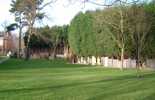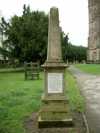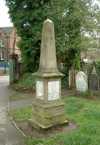For this church:    |
Beeston St John the BaptistChurchyard
The churchyard surrounds the church on all sides, between Church Street to the east and the High Road to the west. To the south is the vicarage and, until recently, the parish church hall. The churchyard is grassed over, with gravestones around the perimeter. There is a path linking the two roads. 138 people who died from plague in 1593/4 were buried in a pit in the east end of the churchyard. Cows were allowed to graze among the gravestones in 1809, when there was a thoroughfare through the churchyard, and a drawing of the present church in 1844 showed sheep grazing. The burial register for 1855-1936 noted after the entry for 27 May 1888 that an Order of Council discontinued burials in the parish church and churchyard except in existing walled graves. All subsequent entries were burials in the consecrated portion of Beeston cemetery.
The churchyard holds a memorial obelisk to those lost in the Crimean War. In 1955 the Vicar and Beeston Rotary Club planned to open up the frontage of the churchyard, by removing the stone wall which had been topped by six foot high railings until their removal during the Second World War. The Rotary Club funded the removal of the wall and laid out a rose garden with paths and seats to commemorate their 50th anniversary. Beeston and Stapleford District Council took over the care of the churchyard in 1956 and moved the gravestones to the perimeter and set grass. In the churchyard there is a yew planted for the Millennium - a scheme to plant young yews from ancient trees estimated to be at least 2,000 years old. |









